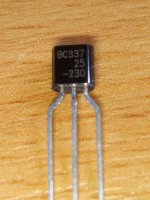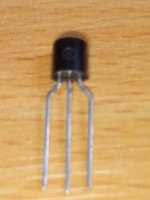hi everyone
firstly i'm an electronics noob
i just purchased a box of fake fairchild bc337-25 from ebay(not for a project just to tinker with), and was wondering how i could test them, so as to compare to the specs of genuine 337's. the fairchild datasheet only gives characteristics information, and no suggested circuits to test.
so far i can continuously draw about 400mA through one of the fakes, but at about 500mA the smoke comes out.
so basically my question is what easy tests can i perform to best compare the fake against the real specs ?
warm regards
gaz
firstly i'm an electronics noob
i just purchased a box of fake fairchild bc337-25 from ebay(not for a project just to tinker with), and was wondering how i could test them, so as to compare to the specs of genuine 337's. the fairchild datasheet only gives characteristics information, and no suggested circuits to test.
so far i can continuously draw about 400mA through one of the fakes, but at about 500mA the smoke comes out.
so basically my question is what easy tests can i perform to best compare the fake against the real specs ?
warm regards
gaz
The humble BC337 can only handle 45V between collector and emmiter (50V across CB, 5V for EB), 800mA from C to E but also just 625mW to dissipate.
With your 500mA, the Vce should be kept lower then (625mW/500mA=) 1.25V.
Check for the beta if it is in the expected range.
How do you know they're fake? And why the sweat?
With your 500mA, the Vce should be kept lower then (625mW/500mA=) 1.25V.
Check for the beta if it is in the expected range.
How do you know they're fake? And why the sweat?
Attachments
thank you for the reply citizen
i dont know for sure that they're fake, but i purchased them from ebay and they were so cheap that i assumed they must be !
the beta is in the expected range. and when i tried to test the 800mA i was running about 15V through some high power led's
no sweat, i just wanted to see how they compared to genuine parts, and was hoping for a couple of circuits that i could use to test them.
warm regards
gazza
i dont know for sure that they're fake, but i purchased them from ebay and they were so cheap that i assumed they must be !
the beta is in the expected range. and when i tried to test the 800mA i was running about 15V through some high power led's
no sweat, i just wanted to see how they compared to genuine parts, and was hoping for a couple of circuits that i could use to test them.
warm regards
gazza
Icmax is 800mA - they're most used in the 1-100mA range, not near the max.
Use a TO126 or TO220 type bjt to drive your leds. With heat sinks.
Use a TO126 or TO220 type bjt to drive your leds. With heat sinks.
For me, first inspection is visual inspection.
Can you post a picture with your "fake " transistors?
Can you post a picture with your "fake " transistors?
Knowing that you bought Fairchild/onsemi bc 327 , the devices in your pictures will not pass my visual inspection. They will go straight to garbage .
Not.how would i pull 800mA through one with out blowing it up ?
Or else place at least 8 in parallel with emitterresistors (approx 1-10Ω range).
As a switch, with Vce less than half a volt.hi citizen
how would i pull 800mA through one with out blowing it up ?
I am not sure they are fake.hi everyone
firstly i'm an electronics noob
i just purchased a box of fake fairchild bc337-25 from ebay(not for a project just to tinker with), and was wondering how i could test them, so as to compare to the specs of genuine 337's. the fairchild datasheet only gives characteristics information, and no suggested circuits to test.
so far i can continuously draw about 400mA through one of the fakes, but at about 500mA the smoke comes out.
so basically my question is what easy tests can i perform to best compare the fake against the real specs ?
warm regards
gaz
TO-92 usually have a max power rating of 0.6W.
That would be 1.2Volt Vce and 500mA.
As said, usually they are used at 50-100mA.
Most any TO-92 would break down with 500mA and more than 1 Volt VCE.
Beta is going to fall at full current rating. But it should stay in the 40 to 50 range. If you force 20 mA into the base, you should be able to pull the collector down to under a volt. If you can’t, then I’d suspect fakes (or some lower current device marked as the higher current one).
The whole reason to choose these devices in the first place is that they are very competitive with those high beta low vce(sat) Zetex parts - at least the ones rated at one amp. That’s what they should be able to do.
The whole reason to choose these devices in the first place is that they are very competitive with those high beta low vce(sat) Zetex parts - at least the ones rated at one amp. That’s what they should be able to do.
hi lineup , i'm not to bothered at all if they're fake, but i would like to know how far i can push them.
thanks for you input
gazza
thanks for you input
gazza
- Home
- Design & Build
- Parts
- BC337 testing

